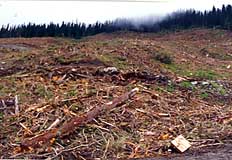CLEARCUTS: Why They're the Worst!


1. They destroy the forest floor with its delicate balance of organisms, root structures and dens. If rare and endangered species are present, they may be lost forever under the tracks of bulldozers.
2. Soils are bared, sunburned, compacted by heavy machines and are subject to surface wash. Because of rapid saturation during rains, they erode and streams are silted up. Nutrients are leached away.
3. The removal of many small logs, which are relatively rich in nutrients, depletes the soil. The result is a gradual decline in forest productivity and increased vulnerability to pollutants such as acid rain.
4. When hardwoods regenerate in clearcuts many sprouts from small trees that were cut rot because they originated high on the stump. Pruning these is expensive. By contrast, selectively cut large hardwoods sprout less and are propagated more by seeds.
5. When conifers such as pine or spruce are planted in clearcuts herbicides that poison watersheds are used to suppress hardwoods.
6. The many small trees of clearcuts are expensive to cut, remove and transport relative to large trees on a board foot or volume basis. The result in National Forests is below cost timber sales.
7. Even-aged stands of trees that result from clearcutting lack the vertical structure and other features of habitat diversity of natural forests of uneven-aged stands.
8. Large snags and den trees are lost during clearcutting or, when saved, soon blow down. In any case our rarest birds and animals don't like to nest and den in clearcuts.
9. Clearcuts and the roads to them fragment habitat in unnatural ways. They create edge effects in a world with too many edge effects already.
10. Clearcuts and their edges encourage alien and native weed species and predators that invade, prey upon and drive out increasingly rare native species of the adjacent forest.
11. Clearcuts provide little hard mast such as acorns and other nutritious food for many years.
12. Clearcuts encourage wildlife that is already common -in many cases to the point of destructiveness- on private lands and discourage our rarest and most endangered species. Thus they are among the threats to our planet's biodiversity.
13. Clearcuts in National Forests benefit large special interests such as paper companies and their contractors by providing cheap government-subsidized pulp wood.
14. Clearcuts also benefit certain U.S. Forest Service bureaucrats by creating jobs for timber managers, road engineers and other land rapers while denying funds to badly needed ecologists.
15. Let's STOP ALL CLEARCUTS!